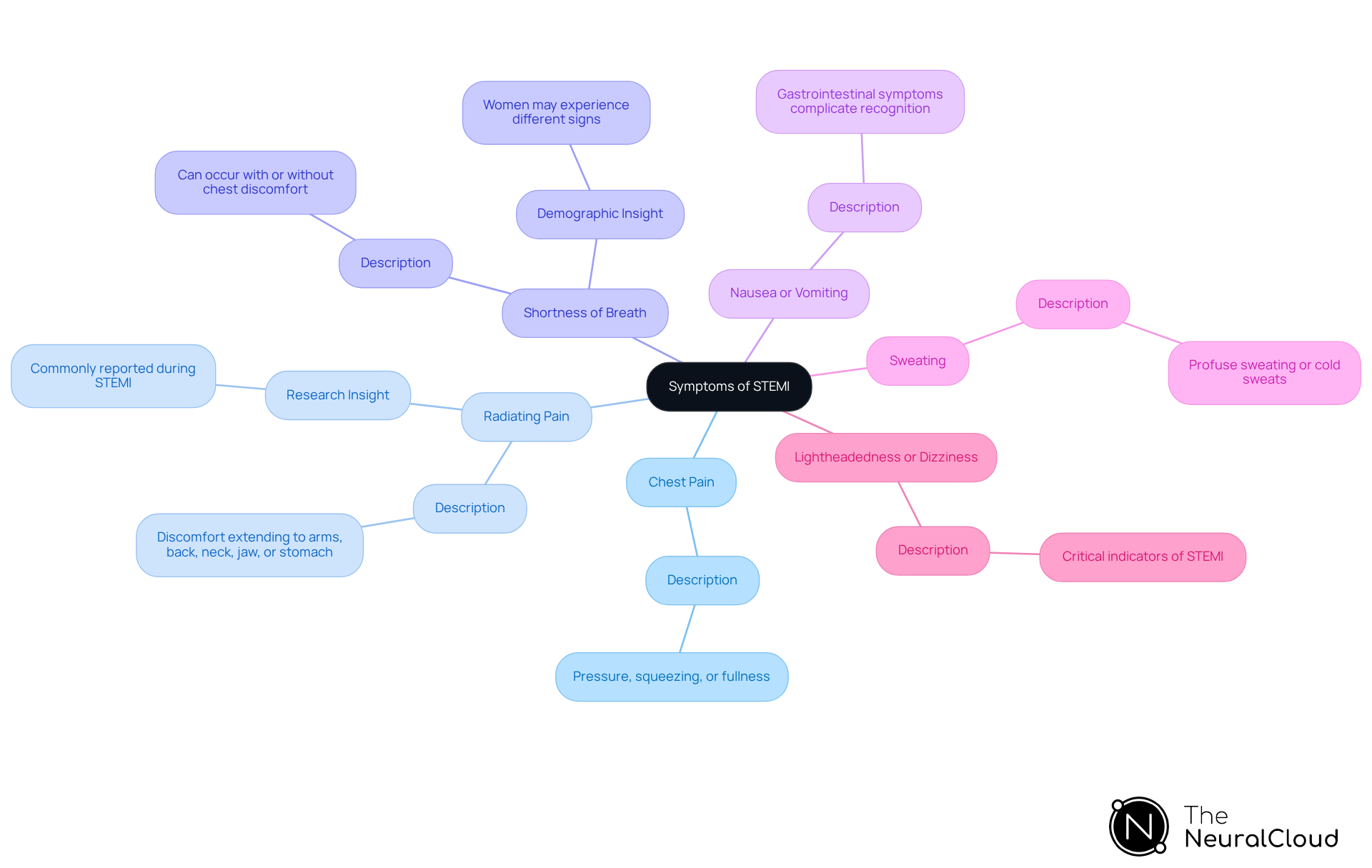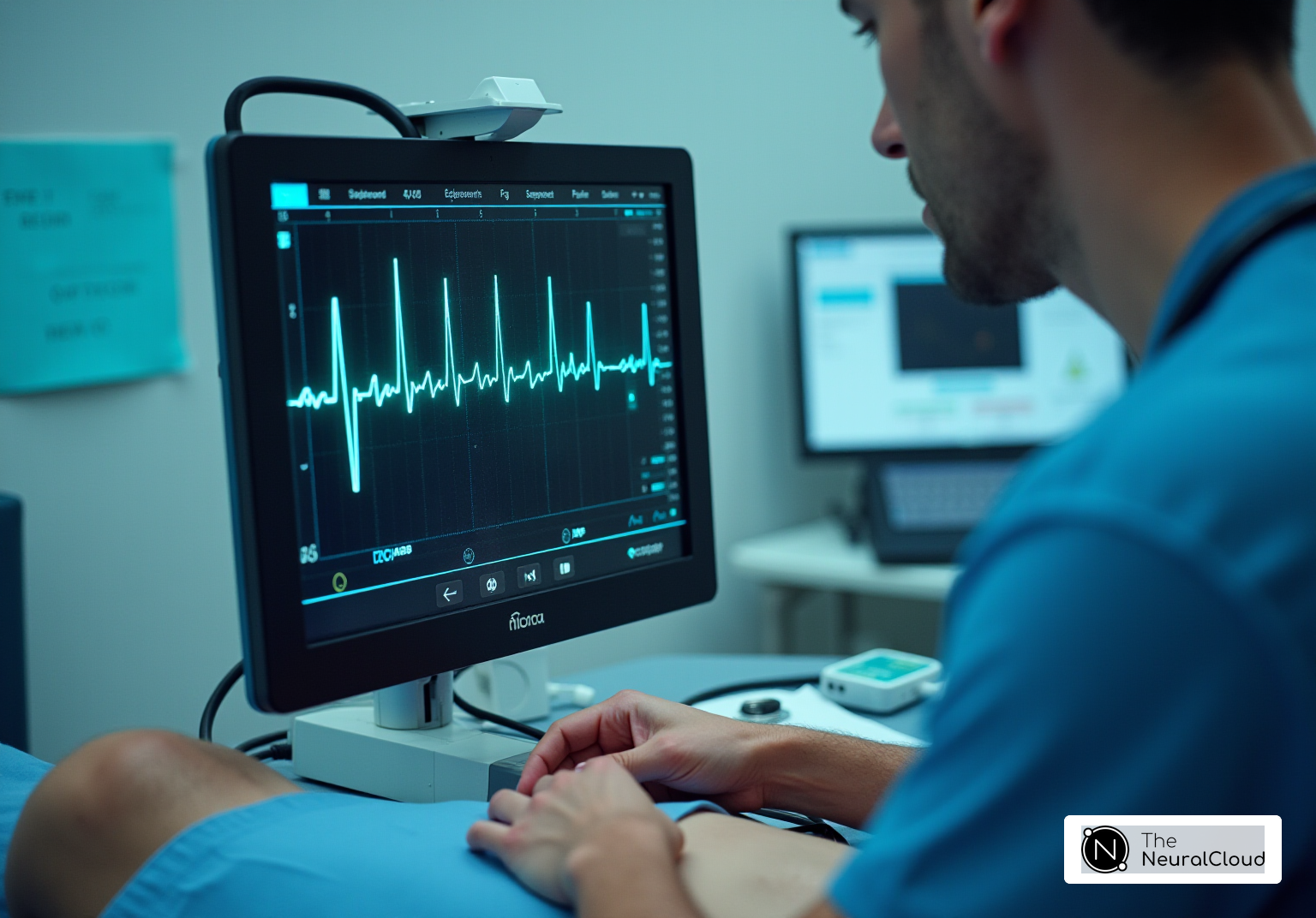Overview
ST segment elevation myocardial infarction (STEMI) represents a critical cardiac event that necessitates immediate medical intervention due to significant blood flow blockage in the heart. This condition is indicated by ST segment elevation on an electrocardiogram (ECG). Rapid diagnosis and treatment are essential in these cases, as delays can adversely affect patient outcomes.
The MaxYield™ platform addresses the challenges in ECG analysis by leveraging advanced technologies, including AI-driven ECG analysis. This innovative approach enhances detection accuracy, allowing healthcare professionals to identify STEMI cases more effectively. By improving the speed and precision of ECG interpretation, MaxYield™ significantly reduces treatment delays.
The advantages of using the MaxYield™ platform are substantial. Healthcare professionals benefit from improved diagnostic capabilities, which ultimately lead to better patient outcomes and higher survival rates. With its user-friendly interface and robust analytical tools, MaxYield™ empowers clinicians to make informed decisions swiftly.
In summary, the integration of AI-driven ECG analysis through the MaxYield™ platform not only streamlines the diagnostic process but also enhances the overall quality of care for patients experiencing STEMI. This platform stands as a vital resource in the fight against cardiac events, ensuring timely and effective treatment.
Introduction
Understanding the complexities of ST Segment Elevation Myocardial Infarction (STEMI) is essential in cardiac health. This serious condition can lead to significant morbidity and mortality if not addressed promptly. The article explores the symptoms, diagnostic methods, and treatment approaches associated with STEMI, highlighting the critical need for swift recognition and intervention. Given the varying presentations of symptoms and advancements in diagnostic technologies, healthcare professionals must be prepared to respond effectively to this life-threatening emergency.
Define ST Segment Elevation Myocardial Infarction (STEMI)
ST segment elevation myocardial infarction (STEMI) is a serious cardiac event characterized by a significant rise in the ST segment of the electrocardiogram (ECG). This elevation signals that a substantial portion of the cardiac muscle is not receiving enough blood due to a blockage in one or more coronary arteries. Recognized as a medical emergency, ST segment elevation myocardial infarction requires immediate intervention to prevent severe heart damage and improve survival rates. Diagnosis primarily relies on ECG findings, which display characteristic patterns indicative of ST segment elevation myocardial infarction in two or more contiguous leads.
Recent studies highlight the critical need for rapid diagnosis and treatment, as delays in reperfusion exceeding 90 minutes can triple mortality rates. In this context, advancements in AI-driven ECG analysis, such as those offered by Neural Cloud Solutions' MaxYield™, show promise in enhancing the early identification of heart attacks. MaxYield™ employs advanced noise filtering and automated analysis to convert noisy recordings into detailed insights, allowing for precise identification of cardiac events.
Features of MaxYield™:
- Advanced Noise Filtering: Enhances the clarity of ECG recordings.
- Automated Analysis: Streamlines the interpretation process.
- Beat-by-Beat Analysis: Processes up to 200,000 heartbeats in under 5 minutes.
These features significantly shorten treatment times and minimize unnecessary emergency activations. One AI ECG model utilizing MaxYield™ detected 553 out of 601 confirmed ST segment elevation myocardial infarctions, surpassing standard triage methods that identified only 427. This technology not only enhances the accuracy of heart attack detection but also integrates seamlessly into existing systems, equipping healthcare professionals with the necessary tools for prompt intervention.
Understanding ST segment elevation myocardial infarction is vital for healthcare professionals, as timely intervention, supported by tools like MaxYield™, can greatly improve patient outcomes and reduce mortality rates associated with heart attacks.

Identify Symptoms of STEMI
The signs of st segment elevation myocardial infarction can vary significantly among individuals, making awareness and identification essential for timely intervention. Common signs include:
- Chest Pain: Often described as pressure, squeezing, or fullness in the center or left side of the chest, this symptom is the hallmark of a STEMI.
- Radiating Pain: Discomfort may extend to the arms, back, neck, jaw, or stomach. Research indicates that many patients report radiating pain during a st segment elevation myocardial infarction, highlighting the necessity for comprehensive awareness of these signs.
- Shortness of Breath: This can occur with or without chest discomfort and is a frequent symptom that may be overlooked. Notably, women may experience different signs during a cardiac event, including shortness of breath, nausea, and pain in the back or jaw.
- Nausea or Vomiting: Gastrointestinal symptoms can complicate the clinical picture, making recognition more challenging.
- Sweating: Profuse sweating or cold sweats are often indicative of a heart attack and should not be ignored.
Lightheadedness or dizziness can be critical indicators of a st segment elevation myocardial infarction, as patients may feel faint or weak.
Swift identification of these indicators is crucial, as timely medical care can significantly improve survival rates. Research shows that prompt intervention, especially within the first few hours of onset, can enhance outcomes and reduce muscle damage. Given the variability in symptom presentation, particularly among different demographics, healthcare professionals must remain vigilant in assessing patients who exhibit these signs. Up to 10% of individuals experiencing a myocardial infarction may die within 30 days, highlighting the importance of recognizing symptoms. The in-hospital mortality rate for myocardial infarctions ranges from 4% to 12%, further emphasizing the critical need for timely intervention. As Uzochukwu Ibe, MD, MPH, states, "If someone has these symptoms, they require immediate medical attention.

Explain Diagnostic Methods for STEMI
The diagnosis of ST Elevation Myocardial Infarction (STEMI) relies on several critical methods:
-
Electrocardiogram (ECG): As the primary diagnostic tool, the ECG is essential for identifying characteristic ST segment elevations, which indicate STEMI. Recent advancements in ECG technology, particularly AI-based analysis like Neural Cloud Solutions' MaxYield™, have significantly improved the detection of ST segment elevation myocardial infarction. MaxYield™ effectively maps ECG signals through noise, isolating and labeling key features in every heartbeat. This innovation has reduced false activations from 42% to just 8%. By analyzing 200,000 heartbeats in under 5 minutes, MaxYield™ facilitates quicker and more accurate diagnoses, enabling timely treatment.
-
Cardiac Biomarkers: Blood tests measuring troponin levels are crucial in diagnosing myocardial injury. Raised troponin levels suggest injury to the cardiac muscle, offering vital insights into the patient's condition. Studies have shown that integrating cardiac biomarkers, particularly troponin, with ECG findings can enhance risk stratification and improve patient outcomes.
-
Coronary Angiography: This procedure visualizes the coronary arteries to identify blockages and is often performed alongside treatment interventions. It plays a pivotal role in confirming the diagnosis and guiding therapeutic decisions.
-
Echocardiography: This ultrasound method evaluates cardiac function and detects regions of inadequate blood circulation, providing further insights into the patient's cardiac condition.
-
Chest X-ray: Although not specific to heart attacks, a chest X-ray can assist in excluding other conditions and evaluating heart size, aiding in a thorough assessment.
Prompt use of these diagnostic methods is essential for effective management of heart attack patients, ensuring that healthcare professionals can make informed choices and initiate appropriate treatment protocols quickly. The integration of platforms like MaxYield™ into clinical workflows enhances the clarity and automation of ECG analysis, addressing challenges such as physiological variability and signal artifacts.

Outline Treatment Approaches for STEMI
Treatment for STEMI is time-sensitive and typically involves several key approaches:
-
Reperfusion Therapy: This is the primary treatment goal, which can be achieved through:
-
Percutaneous Coronary Intervention (PCI): A minimally invasive procedure that opens blocked arteries using a balloon and stent.
-
Thrombolytic Therapy: Medications that dissolve blood clots, administered when PCI is not immediately available.
-
-
Medications: Patients may receive antiplatelet agents (e.g., aspirin, clopidogrel), anticoagulants, beta-blockers, ACE inhibitors, and statins to manage symptoms and prevent further complications.
-
Cardiac Rehabilitation: After treatment, patients are often enrolled in rehabilitation programs aimed at improving cardiovascular health and preventing future events.
-
Lifestyle Modifications: Education on diet, exercise, and smoking cessation is crucial for long-term management.
Timely and effective treatment can significantly reduce the risk of complications and improve survival rates in patients with STEMI.

Conclusion
Understanding ST segment elevation myocardial infarction (STEMI) is crucial for timely intervention and effective patient care. This serious cardiac event, marked by significant ST segment elevation on an electrocardiogram, demands immediate medical attention to prevent severe heart damage and enhance survival rates. Advanced diagnostic tools, particularly AI-driven ECG analysis like MaxYield™, play a pivotal role in the early identification and management of STEMI, ultimately improving patient outcomes.
The article delves into the symptoms associated with STEMI, emphasizing the variability in presentation among individuals. Recognizing key indicators such as chest pain, shortness of breath, and radiating discomfort is essential for prompt medical response. Diagnostic methods, including ECG, cardiac biomarkers, and coronary angiography, are highlighted as vital components in accurately diagnosing STEMI. Furthermore, treatment approaches discussed, including reperfusion therapy and lifestyle modifications, underscore the importance of timely intervention in reducing complications and enhancing recovery.
In conclusion, awareness of STEMI symptoms, coupled with rapid diagnosis and effective treatment strategies, is critical in the fight against heart attacks. Healthcare professionals must remain vigilant and equipped with the latest technologies to ensure prompt care. By prioritizing timely intervention and leveraging advancements in diagnostic methods, the healthcare community can significantly improve the prognosis for patients experiencing ST segment elevation myocardial infarction.
Frequently Asked Questions
What is ST segment elevation myocardial infarction (STEMI)?
ST segment elevation myocardial infarction (STEMI) is a serious cardiac event characterized by a significant rise in the ST segment of the electrocardiogram (ECG), indicating that a substantial portion of the cardiac muscle is not receiving enough blood due to a blockage in one or more coronary arteries.
Why is STEMI considered a medical emergency?
STEMI is considered a medical emergency because it requires immediate intervention to prevent severe heart damage and improve survival rates.
How is STEMI diagnosed?
STEMI diagnosis primarily relies on ECG findings that display characteristic patterns indicative of ST segment elevation in two or more contiguous leads.
What are the consequences of delays in treatment for STEMI?
Delays in reperfusion exceeding 90 minutes can triple mortality rates for patients experiencing STEMI.
What advancements are being made in the diagnosis of STEMI?
Advancements in AI-driven ECG analysis, such as those offered by Neural Cloud Solutions' MaxYield™, are enhancing the early identification of heart attacks by improving the clarity and interpretation of ECG recordings.
What features does MaxYield™ offer for ECG analysis?
MaxYield™ offers advanced noise filtering to enhance ECG clarity, automated analysis to streamline interpretation, and beat-by-beat analysis that processes up to 200,000 heartbeats in under 5 minutes.
How does MaxYield™ improve the detection of STEMI?
An AI ECG model utilizing MaxYield™ detected 553 out of 601 confirmed STEMIs, surpassing standard triage methods that identified only 427, thus enhancing the accuracy of heart attack detection.
Why is understanding STEMI important for healthcare professionals?
Understanding STEMI is vital for healthcare professionals because timely intervention, supported by tools like MaxYield™, can greatly improve patient outcomes and reduce mortality rates associated with heart attacks.






